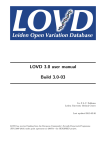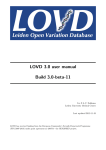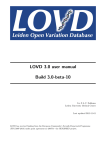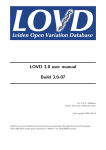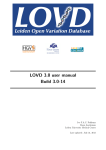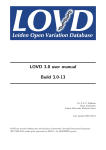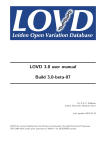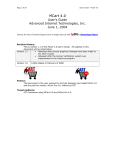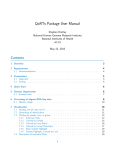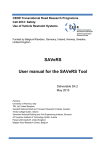Download LOVD 3.0 user manual Build 3.0-05
Transcript
LOVD 3.0 user manual Build 3.0-05 Ivo F.A.C. Fokkema Leiden University Medical Center Last updated 2013-06-25 LOVD has received funding from the European Community’s Seventh Framework Programme (FP7/2007-2013) under grant agreement no 200754 - the GEN2PHEN project. Contents Contents 1 1 Introduction 2 2 Installing LOVD 2.1 Before you install . . . . . . . . . . . . . . . . . . . . . . . . . . . . . . . . . . . 2.2 Install process . . . . . . . . . . . . . . . . . . . . . . . . . . . . . . . . . . . . . 4 4 5 3 LOVD Setup 10 3.1 LOVD system settings . . . . . . . . . . . . . . . . . . . . . . . . . . . . . . . . 10 3.2 System logs . . . . . . . . . . . . . . . . . . . . . . . . . . . . . . . . . . . . . . 13 3.3 Uninstalling LOVD . . . . . . . . . . . . . . . . . . . . . . . . . . . . . . . . . . 15 4 Authorized users 4.1 Registering a new account . . . 4.2 Creating new user accounts . . 4.3 Editing user accounts . . . . . . 4.4 Locking users out of the system . . . . . . . . . . . . . . . . . . . . . . . . . . . . . . . . . . . . . . . . . . . . . . . . . . . . . . . . . . . . . . . . . . . . . . . . . . . . . . . . . . . . . . . . . . . . . . . . . . . . . . . . . . . . 16 17 19 20 21 5 Gene databases 5.1 Creating a new gene database . . . . 5.2 The gene homepage . . . . . . . . . . 5.3 Editing a gene database . . . . . . . 5.4 Deleting a gene database . . . . . . . 5.5 Assigning curators and collaborators . . . . . . . . . . . . . . . . . . . . . . . . . . . . . . . . . . . . . . . . . . . . . . . . . . . . . . . . . . . . . . . . . . . . . . . . . . . . . . . . . . . . . . . . . . . . . . . . . . . . . . . . . . . . . . . . . . . . . . . . 22 22 26 26 27 27 6 Gene transcripts 6.1 Which transcript(s) should 6.2 Creating new transcripts . 6.3 Editing a transcript . . . . 6.4 Deleting a transcript . . . . . . . . . . . . . . . . . . . . . . . . . . . . . . . . . . . . . . . . . . . . . . . . . . . . . . . . . . . . . . . . . . . . . . . . . . . . . . . . . . . . . . . . . . . . . . . . . . . 30 30 30 31 31 7 Custom columns 7.1 Custom column categories . . . . . . . 7.2 Creating a new custom column . . . . 7.3 Enabling custom columns . . . . . . . 7.4 Editing custom column settings . . . . 7.5 Changing the order of custom columns 7.6 Disabling custom columns . . . . . . . . . . . . . . . . . . . . . . . . . . . . . . . . . . . . . . . . . . . . . . . . . . . . . . . . . . . . . . . . . . . . . . . . . . . . . . . . . . . . . . . . . . . . . . . . . . . . . . . . . . . . . . . . . . . . . . . . . . . . . . . . . . . . . . . . . . . . . . . . . 32 32 33 37 38 40 41 I . . . pick? . . . . . . . . . . . . . . . . . 1 1. Introduction This is the manual for the Leiden Open (source) Variation Database (LOVD) version 3.0. LOVD 3.0 is a partial rewrite of LOVD 2.0, which first stable release was completed in 2007. Also, LOVD 3.0 has a greatly improved database model, and includes lots of new features aimed at making LOVD useful for more research environments. LOVD is designed to provide a flexible, freely available tool for gene-centered collection and display of DNA variations. LOVD 3.0 extends this idea to also provide patient-centered data storage and storage of NGS data, even of variants outside of genes. LOVD was developed approaching the “LSDB-in-a-Box” idea for the easy creation and maintenance of a fully web-based gene sequence variation database, that is platform-independent and uses PHP and MySQL open source software only. The design of the database follows the recommendations of the Human Genome Variation Society (HGVS) and focuses on the collection and display of DNA sequence variations, but it has fully implemented methods for storing complete clinical data as well. The open LOVD setup also facilitates functional extensions with scripts written by the community. The development of (then nameless) LOVD started in late 2002, while it was first officially released in January, 2004. Before that LOVD was only in use by the Leiden Muscular Dystrophy pages, as a not-so-modular system with lots of characteristics specific for that website only. With the official release of LOVD in 2004 the system had become much more dynamic and customizing LOVD was made easy mostly by editing text-files. In 2004, LOVD became available under the open source license GPL and with the 1.1.0 release most of the text-files had been replaced by online forms so customizations can be performed through the web interface. Early in 2005 the first LOVD article was published, and in 2005 the development of LOVD was more targeted at improving the ease of use of the system. In 2006 the development of LOVD 2.0 started after the decision was made to rewrite all of LOVD from scratch to be able to include a long list of upgrade suggestions that were hard to implement in LOVD 1.1.0. Aimed at modularity and data redundancy, LOVD 2.0 was meant to be a more flexible and more powerful successor of the popular 1.1.0 version and soon it received the interest of LOVD users eager to try out the all-new version. With more features being added and bugs fixed rapidly, LOVD 2.0 reached beta stage in April 2007, after which more and more users started to upgrade their 1.1.0 databases to 2.0. Finally, in October 2007 LOVD 2.0 reached the stable stage, after which LOVD 2.0 was continuously improved with monthly releases for two years, after which the releases became less frequent. LOVD 2.0 is described in the second LOVD paper. By 2009 it had became clear that although LOVD 2.0 was a great step forward, there were still key improvements to be made. Since the complexity of necessary changes had become to great to gradually upgrade LOVD 2.0 systems to include these options, it was again decided to start from scratch writing LOVD 3.0. This allowed us to redesign the complete data model in full freedom, although it should still be possible for existing LOVD 2.0 databases to have all data transferred to LOVD 3.0. LOVD 3.0 adds even more flexibility, allowing users to focus exclusively on sequence variants, whilst also allowing an exclusive focus on individuals and clinical data, and anything in 2 1. Introduction between. It will be possible for different submitters to work together cooperatively on the same data. Searching through the data is improved extensively, and webservices of many different sources are used to automatically retrieve gene and transcript information. Also new in 3.0 is full Next Generation Sequencing (NGS) support, with the ability to import VCF or SeattleSeq formats. For VCF file imports, LOVD allows for automatic annotation of the variants. Both formats support the automatic creation of genes and transcripts in the system, greatly reducing the amount of work required by curators to get LOVD set up for their research data. LOVD 3.0 reached beta stage in January 2012. Currently, the latest release is 3.0-05. Keep an eye on our news page for the latest information on LOVD 3.0 development. Wherever you see “he” or “his” written in this manual, it should read “he or she” and “his or her” respectively. Please note that this manual is work in progress. Since LOVD 3.0 is still under development and the development is the focus of our efforts, most features in LOVD 3.0 are not yet described in this manual. Also, features described in this manual may become inaccurate or even incorrect in later versions of LOVD 3.0. Please bear with us while we finish this manual. 3 2. Installing LOVD Please note that if you’re just going to use an LOVD installation that already exists, you do not need to install anything on your computer. Any web browser that you already have installed, such as Mozilla Firefox, Google Chrome or Microsoft Internet Explorer, will do. This chapter describes how to install a new LOVD. Installing LOVD is a “piece of cake”. However, you might require help from your system administrator, since there are a few dependencies that need to be taken care of first. 2.1 Before you install LOVD is a web-based software project. Therefore, installation requires a correctly set-up webserver. A suitable server with the necessary software installed is available at virtually all academic institutions and countless commercial hosting providers. If you don’t want to run LOVD on a server but rather want to have it running on your computer, we can recommend the XAMPP package, which installs all needed software on your computer regardless of whether it’s Linux, Windows or Mac. Also, at the time of this writing, we are offering free server space if you need to set up an LOVD. Contact us for more information. In that case you don’t need to install anything and you can skip this chapter. If you’re experienced with web servers and you want to set it up yourself: LOVD has been extensively tested with the Apache webserver, but any webserver able to run PHP scripts should suffice. You’ll need PHP 5.2.0 or higher (or PHP 5.0.0 with PDO and JSON en/decode enabled) and MySQL 4.1.2 or higher. LOVD may work with other database platforms, but we are not developing for other database backends. You are welcome to try other database backends and report the results to us, but we can’t provide any support for it. For more information, see the FAQ about software needed. Before installing LOVD, be sure you have the required credentials for connecting to the MySQL database. You need a hostname, username, password and a database name to be able to install LOVD. If you are installing LOVD on a remote server, be sure to have the FTP username and password to be able to copy the necessary files to the server. Download & Extract To download LOVD, go to the LOVD website and click on the “Download” tab. You can download LOVD in two formats; GZIPped TARball and ZIP archive. The first format is common for Unix and Linux systems while the ZIP archive is popular on the Windows platform. Usually you will be able to open both formats. Download the file of your choice and save it to your hard drive. Now extract the file using GZIP/TAR or ZIP to the desired location. On a server, common directories may be /var/www on Unix or Linux servers, or C:\htdocs on a Windows server. When using XAMPP, the directory is C:\xampp\htdocs for Windows, /opt/lampp/htdocs for Linux, or /Applications/XAMPP/htdocs for Mac. To be sure, consult the documentation of the webserver software you are using. 4 2. Installing LOVD Install process Pre-install Setup You will need to rename the standard config file config.ini.php-lovd to config.ini.php and edit it in, for example, a basic text editor. This is absolutely mandatory, because you will need to enter the MySQL hostname, username, password and database name here. In case you’re using XAMPP, the needed values are “localhost”, “root”, “” (empty) and “test”, respectively. No quotes around the values needed. Please note that these are not the recommended settings for production environments, but it will help you quickly set up LOVD on your computer. Please go through the entire config.ini.php file to determine if you need to change any of the other settings. A .htaccess file is put in the root directory of your LOVD installation protecting the config.ini.php file. This will prevent the config file from being accessed by others on Apache HTTP servers (if configured properly), the most commonly used webserver. If you use Apache, please check that your version and configuration support this feature. Make sure you have the .htaccess file into your LOVD directory, on Unix and Linux systems it’s a hidden file so it can be missed easily. For the .htaccess file to work, you need to have “Limit” and “Options” enabled in Apache’s “AllowOverride” setting. Also, make sure you have MultiViews or mod_rewrite enabled. This allows a PHP file like “/setup.php” to be accessed as “/setup”. More information about .htaccess files: http://httpd.apache.org/docs/2.0/howto/htaccess.html More information about AllowOverride: http://httpd.apache.org/docs/2.0/mod/core.html#allowoverride If you use a different webserver, make sure to configure it to deny access to the config.ini.php file. LOVD will access the file through the filesystem. Also, the .htaccess file sets a couple of PHP options and enables mod_rewrite. If you use a different webserver, please disable the following PHP options: register_globals, magic_quotes_gpc, mysql.trace_mode. Also make sure there is “MultiViews” functionality, which allows a PHP file like “/setup.php” to be accessed as “/setup”. 2.2 Install process To install LOVD on a remote webserver, upload the LOVD directory with all the files to the webserver by, for instance, FTP. If you install LOVD on your own computer, you do not need to follow this step. Next, point your web browser to the directory where you’ve uploaded the LOVD files. This could, for instance, be http://localhost/LOVDv.3.0/ or http://www.your-domain.org/LOVD/. LOVD will tell you it’s not installed yet, and include a link to the install directory. LOVD will first check a few requirements. Both the PHP and MySQL versions will be checked, to make sure your LOVD will function properly on your webserver environment. Also some settings of the web server, PHP and MySQL will be checked. Finally, LOVD will check if your config file has been hidden. If all looks well, LOVD will tell you all requirements are OK and you’re ready to start installing LOVD. 5 2. Installing LOVD Install process Figure 2.1: When pointing your browser to the LOVD location, it will tell you it’s not installed yet. Click the link to start the install process. Installing LOVD consists of only 4 simple steps and will take only a couple of minutes, or less. Figure 2.2: If all requirements are OK, you’re ready to start installing LOVD. Administrator account details Fill in the database administrator data to install LOVD. The database administrator will be the first user registered with LOVD and has full access to all of LOVD’s functionalities. The database administrator is the only user capable of creating manager accounts. Managers can only create curator and submitter accounts. Most of the form is pretty straight forward, but I will highlight one field - “Allowed IP address list”. An IP address is an address a computer is known by on the network. To help prevent others to try and guess the username/password combination, you can restrict access to the database administrator account to a number of IP addresses or ranges. This also means you need to be very careful with this setting, as being too restrictive may lock you out of your account. The default, unrestricted, value is *. The database administrator is the absolute owner of the LOVD installation. Not only is he the only one that can uninstall LOVD from the database using the uninstaller, he will also be able to create, edit or delete all user accounts in the system and (depending on the settings) receive submission and registration notifications. 6 2. Installing LOVD Install process Figure 2.3: The database administrator registration form, with example data filled in. After completing the database administrator account details, click the “Continue »” button at the bottom. LOVD will apply a simple username and password quality check. If LOVD tells you that the provided details are OK, click the “Next »” button. Installing database tables The next step is to create and fill all necessary LOVD database tables. LOVD will do this automatically, and you can watch the progress bar complete while the tables are created, the country list filled, the database administrator account created, the custom columns preconfigured, the standard columns enabled, and the custom links generated. This may take a while on non-optimal conditions, so please be patient. When everything is done, a “Next »” button appears - click it to continue. Configuring LOVD system settings The final form in the installation process is completing the initial configuration of the LOVD system settings. These settings can be changed after installation at any time through the LOVD setup. The only setting that cannot be changed at a later time, is the install lock, which is checked by default. Setting the uninstall lock will prevent uninstallation of LOVD by the database administrator. The only way to remove this lock is directly through the MySQL database backend. 7 2. Installing LOVD Install process Figure 2.4: Watch the progress bar complete while LOVD informs you which part of the database table installation is currently in progress. For more information on the options of the LOVD system settings, see the LOVD system settings section of the manual. After filling in the form, click “Continue »”. If everything was filled in correctly, LOVD will register the LOVD system settings. Click “Next »” to continue to the last step. Almost done! 8 2. Installing LOVD Install process Figure 2.5: The system settings form, with example data filled in. Done When everything has been filled in and stored correctly, the installation is complete. Now that you’re done installing LOVD, click the “Continue to Setup area »” button to be forwarded to the LOVD setup area. From there, you can perform the most important actions for managers in LOVD, such as creating new gene databases or disease information entries, registering new user accounts or authorizing curators, or manage the custom columns and links. The button to create a new gene will be highlighted, as a suggestion of your next step! 9 3. LOVD Setup To change system-wide settings, but also to perform actions with system-wide effects, start at the LOVD setup area. The setup area is only available for managers and the database administrator and can be accessed by clicking on the “Setup” tab in the menu. If you do not see a “Setup” tab, you first need to log into the system with a manager or administrator account. The LOVD setup shows some statistics on the left of the screen, like date of installation, number of registered users and variant counts, separated by status. Furthermore, there are two columns of options. The left column has options for the system settings, authorized users, the custom columns, custom links, full data download and the LOVD system logs. The right column has options for genes, transcripts, diseases, individuals and variants. Some of the general options from the LOVD setup are also available through the Setup tab’s dropdown menu, allowing you to quickly navigate to other setup options without having to go through the setup main page. The other options shown in the setup area are available through their own tab’s dropdown menus. In this chapter, we will describe changing the LOVD system settings, how to check, search and clean up the LOVD system logs, and how to uninstall LOVD. The other actions available from the LOVD setup are described in their respective chapters (see the table of contents). 3.1 LOVD system settings The LOVD system settings allow you to adapt Required level: Manager your LOVD installation to your preferences. For Available from: LOVD 3.0 Build 01 instance by changing the installation’s displayed name or email address (general settings), proxy server settings (connection settings), settings on statistics, or the security settings. To view or edit the LOVD system settings, click on the “Setup” tab, then on “View and change LOVD System settings (...)”, or move your mouse over the “Setup” tab and click the “LOVD system settings” menu option from the dropdown list. General system settings Title of this LOVD installation This title will be shown on the top of every page, above the menu tabs. The default value is “LOVD - Leiden Open Variation Database”. Institute The institute which runs this database is displayed in the public area and in emails sent by LOVD. It’s commonly set to a laboratory name or a website name. If it’s not specified, LOVD will use the (autodetected) website name LOVD has been installed on. 10 3. LOVD Setup LOVD system settings Database URL This is the URL with which the database can be accessed by the outside world, including “http://” or “https://”, and is not necessarily the URL you are using right now to access the database. It will also be used in emails sent by LOVD. This field is mandatory if you select the “Include in the global LOVD listing” option. If you click the “check” link, LOVD will verify or try to predict the value. LOVD email address This email address will be used to send emails from LOVD to users. LOVD needs this address to prevent problems with spam filters, to make sure that emails from LOVD arrive. Please note that although strictly speaking this email address does not need to exist, we recommend that you use a valid address to make sure that bounces of emails sent from LOVD (to submitters or curators) are still caught by someone, so that they can be handled. Forward messages to database admin With this setting enabled, LOVD will forward messages to the database administrator about submitter registrations, submissions, and such. Human Build to map to (UCSC/NCBI) This value can only be set during installation, and cannot be changed later. It defines on which version of the Human Build (hg18/Build 36.1 or hg19/GRCh37) genomic variants are described. Links to the UCSC and Ensembl genome browsers and the NCBI sequence viewer also depend on this setting. From LOVD 3.0-beta-07, the hg18 setting is no longer available for new LOVD installations, although it will remain to be supported. When hg20 will come out, LOVD will start supporting multiple genome builds per installation. List database changes in feed for how long? Note: Not yet implemented! LOVD includes a “newsfeed” that allows users to get a list of changes recently made in the database. Select here how many months back you want changes to appear on this list. Set to “Not available” to disable the newsfeed. Connection settings (optional) Some networks have no access to the outside world except through a so-called proxy server (more info on WikiPedia). If this applies to the network this server is installed on, please fill in the proxy server information here. Proxy server host name The host name of the proxy server, such as “www-cache.institution.edu”. Proxy server port number The port number of the proxy server, such as 3128. Proxy server username In case the proxy server requires authentication, please enter the required username here. Proxy server password In case the proxy server requires authentication, please enter the required password here. 11 3. LOVD Setup LOVD system settings Customize LOVD Here you can customize the way LOVD looks. Right now, there is only one option included, we will add more later. System logo If you wish to have your custom logo on the top left of every page instead of the default LOVD logo, enter the path to the image here, relative to the LOVD installation path. If left empty, it will be set to the default value, which is “gfx/LOVD_logo130x50.jpg”. Currently, only images already uploaded to the LOVD server are allowed here. Global LOVD statistics Your LOVD installation can send some general information on your installation back to us. We use this information to see how many LOVDs there are worldwide, which versions of LOVD are currently in use, how LOVD is being used (amount of data), to see what type of software is used to run LOVD and to construct the public list of LOVD installs. Send statistics When this setting is enabled, LOVD will collect general usage statistics and send this to us. The following information is sent: the number of submitters, genes, individuals, variants and unique variants in your system. No specific information is sent, just the numbers. Include in the global LOVD listing On our website, we keep a list of public LOVD installations. This list is also feeding our worldwide LSDB list, through which submitters can locate databases for a specific gene to submit data to. If you enable the “Include in the global LOVD listing” setting, your LOVD installation will send us all the information we need to build these lists: the LOVD installation’s name, the URL, the available gene databases, the date of last update of the gene databases, the disease abbreviations and names of the diseases related to these genes and finally the names, institutes and email addresses of the curators of these gene databases. If you change this setting, please allow one day for the setting to take effect. Security settings In this section you can control some security settings of LOVD. Lock users after 3rd failed login? With this setting enabled, submitters, curators and managers will be locked out of the system after they have provided the wrong password three times. A manager or, in the case of a locked manager, the database administrator needs to unlock the user’s account once it’s locked. This does not affect the database administrator account. Allow (locked) users to retrieve a new password? If a submitter, curator, or manager has lost his password, enabling this “I forgot my password” feature allows them to receive a unlocking code in their email with which they can unlock their account and choose a new password. Enable submitters to change data? This setting allows submitters to make changes to data previously submitted by them or assigned to them. 12 3. LOVD Setup System logs Enable getting counts of hidden entries? Note: Not yet implemented! Enabling this feature allows the public to find the number of entries in the database (including hidden entries) matching one or more search terms on a specified set of columns. This feature will only mention the number of variant entries matched, without showing them. Force SSL-only access to LOVD? SSL is a secure protocol allowing for encryption of data sent between you and LOVD. When you record sensitive individual information in LOVD, you should enable this setting, as the individual information can otherwise be “sniffed” off the network. If you do not record sensitive information, enabling SSL is recommended. Use data versioning of biological data? Note: Not yet implemented! Versioning allows you to see all previous versions of a certain data entry (individuals, variants, phenotype information, etc) and allows you to return the entry to a previous state. Please note that this feature requires quite a lot of space in the database. Disabling this feature later will not free any space, just prevent more space from being used. 3.2 System logs System logs were introduced in LOVD 2.0 to allow authorized users to keep track of events in LOVD. This can be for security purposes, to follow each other’s progress when working together, went wrong. The logs are initiated when LOVD is Required level: Manager Available from: LOVD 3.0 Build 01 or to track down errors in case something installed. What is logged by LOVD LOVD logs four types of events: authorization events and errors, general events, general errors, and installation and upgrade events. In case the event or error was triggered by an authorized user, the username of this user is also logged. Authorization events and errors (“Auth”) This list stores all successful and unsuccessful login attempts and password reset attempts. In all cases, the IP address from where the login or password reset attempts have been made, is also logged. For successful and unsuccessful login attempts the given username and the length of the given password is stored, so you can easily uncover brute force attempts where in general the attacker will try many random passwords. If a user can’t log in because of the IP restriction on the account, the current IP restriction is also stored in the log entry. Please note that it is recommended to have LOVD lock user accounts after three failed login attempts. See subsection Security settings for more information. General events (“Event”) General events are logged to show a user’s activity, to allow collaborating users to track each other’s activities or to check what happened to a certain data entry over time. 13 3. LOVD Setup System logs General errors (“Error”) Whenever an unrecoverable error occurs, LOVD logs the error and stops processing. Also some non-fatal errors are logged, such as when only part of the requested action could be completed. In principle, during any database event, an error can occur. This is then logged under the name of the event, so any of the event names used in the general event log can also be found in the error log. Installation and upgrade events (“Install”) LOVD creates a log entry on completion of the LOVD installation procedure. Also, after each upgrade, LOVD will add an entry stating from which version to which version it has been upgraded, and how many database queries have been used for the upgrade. Also errors during an LOVD upgrade, might they occur, will be logged here. Viewing and searching through the logs To browse the system logs, click the “View system logs” option of the “Setup” tab dropdown menu, or the “View, search and delete system logs” link in the setup area. The system log overview is fully searchable and sortable, allowing you to find log entries quickly. The “Log” column shows the type of log every - Auth, Event, Error or Install. The “Date” column shows the date the log entry was created. The “User” column shows, if available, which user caused the log entry to be created. The “Event” column lists the type of event that occurred. Finally, the “Entry” column provides more information about the event that has occurred. For login attempts, it will contain the IP address of the user attempting to log in. For most event types, it will include the ID of the entry that was created, edited or deleted. Removing log entries To remove a single log entry, click on the red cross in the 6th Delete log entry column. To remove multiple log entries at once, first apply as Options menu button many search terms on the log entries as needed to restrict the view to the entries you want to delete. Either manually select the checkboxes next to the entries you want deleted, or click the option button on the top left of the log overview, and select the “Select all ... entries” option, after which you can deselect log entries you do not want deleted. Then, open the option menu again and click the “Delete selected entries” option. Please note that deleting log entries can not be undone. 14 3. LOVD Setup 3.3 Uninstalling LOVD Uninstalling LOVD Only the database administrator can uninstall Required level: Database administrator LOVD, provided the uninstall lock has not been Available from: LOVD 3.0 Build 01 set during installation of LOVD. The uninstall lock is set within the MySQL database and can only be removed by directly accessing MySQL. If you know how to handle MySQL, you can also uninstall LOVD through MySQL directly, by removing all LOVD tables, but this is not recommended. To uninstall LOVD and remove all data stored in LOVD, click on the “Uninstall LOVD” link in the setup area. This link is only available if the uninstall lock is disabled. You will need to fill in the database administrator’s password twice to complete the uninstallation process. Once you have uninstalled LOVD, you have lost all variant and individual information. If you wish to store these data elsewhere, make sure you download all data first! Please note that the LOVD uninstaller will not remove the LOVD files itself, just the database tables that it has created during install. Thus, to completely remove LOVD from the system, also remove the files from the server. 15 4. Authorized users In LOVD 3.0, authorized users are everyone who registered for an account at the LOVD installation, including the database administrator who created his account during the installation process. The authorized users come in five levels; the database administrator of which there is only one, managers, curators, collaborators and submitters. The different levels of users are described in more detail below. Registering for an account is necessary to be able to submit data or to become a gene curator. Directly after registering, you are allowed to submit individual, phenotype and variant data to the database, but the data needs to be checked and published by a curator or a manager. Curators and managers can submit and publish data in one step. User levels Database administrator The database administrator is the first user within LOVD; this account is created during the installation of LOVD. After installation, the database administrator can create other users (managers, curators and submitters) in the system, if desired. These users can also register themselves, after which the database administrator can upgrade them. The administrator has full access to all areas and settings of LOVD. The administrator is also the only user who can uninstall LOVD, provided the uninstall lock has not been set during LOVD installation. When the “Forward messages to database admin” setting in the LOVD system settings is enabled, the database administrator will receive copies of submitter registrations and data submissions or edits. Manager A manager has access to almost everything the database administrator has access to. However, the manager is not able to create new managers or to edit existing managers. Also, a manager cannot uninstall LOVD even if the uninstall lock is not in place. A manager can only be created by the administrator and often assists the administrator or takes over the customisation of LOVD for the curators. Curator The curator level user is actually a submitter, which has been given curatorship of one or more genes. Therefore, a curator only has access to the gene databases he is appointed to, and not to the system-wide setup area. However, also the database administrator or a manager can act as a curator by being appointed to certain genes, but in this case there is of course no restriction in access. To assign a user to become curator, follow the steps explained in section “assigning curators and collaborators” (available for managers and up). 16 4. Authorized users Registering a new account Collaborator The collaborator level user is a new type of user, introduced in LOVD 3.0. Collaborators are submitters with read access to non-public data on a certain given gene. Just like curators, these users must be appointed to genes by managers or the database administrator. See section “assigning curators and collaborators” for more information. Submitter Submitters have no special rights except to submit data to the database, which then needs to be checked and published by curators or managers. Depending on the LOVD system settings, submitters are also able to edit the data they have submitted previously. Submitter accounts can also be created, edited or deleted by managers or the database administrator, although usually this should not be necessary. Curators do not require a separate submitter account; they can use their curator account to submit new data. 4.1 Registering a new account Please note that you do NOT need to register to view the data available in the database. You only need an account for submitting new variant data. Anyone can create a new submitter account. For collaborators, curators or managers, registering as a submitter is often the first step; their account can then be upgraded by a manager or the database administrator, respectively. The major difference between registration and direct creation of a new account by a manager or the database administrator, is that the registration can be performed by the public, and therefore it requires you to be logged out of LOVD. The registration form is protected using a reCAPTCHA module, which makes sure the form can only be used by humans, and not by spam bots. To register a new submitter account, click Required level: None (public) the “Register as submitter” link on the top right Available from: LOVD 3.0 Build 01 corner of the screen, next to the “Log in” link. First, you are asked to provide an ORCID ID, if you have one. ORCID provides a persistent digital identifier that distinguishes you from every other researcher and, through integration in key research workflows such as manuscript and grant submission, supports automated linkages between you and your professional activities ensuring that your work is recognized. If you don’t have an ORCID ID yet, you can get one created by using the register link also given on the page. If you don’t want to register at ORCID at this time, click the “I don’t have an ORCID ID »” button to continue to the registration page. If you do have an ORCID ID, fill it in and click the “Continue »” button. Your ORCID ID will be verified, and the associated data is shown on the screen. If this data is correct, click “Yes, this is correct »” to continue to the registration page. As much information as possibly will be pre-filled for you. If the information shown is not correct, click “« No, this is not correct” so you can try and enter a correct ORCID ID or register without using one. 17 4. Authorized users Registering a new account User details This part of the registration form contains the basic fields with which the user identifies himself. Name Please enter your name in the way you want to be referenced to; usually in the format “<First name> <Last name>”. Institute The institute for which you work. Deparment If your institute consists of department, please enter the department for which you work. Postal address Please provide the full postal address of your institute. Email address(es), one per line Your account can hold multiple email addresses, which will all receive notifications sent by LOVD. This is useful if you’re sharing an account with a colleague, or when you would like to also get emails on a different account. You can enter as many email addresses as you like, one email address per line, no spaces, quotes or other special characters allowed. Telephone Optionally, provide your phone number where you can be reached. Username LOVD requires the username to be 4 to 20 characters long, and starting with a letter followed by letters, numbers, dots, underscores and dashes only. Password LOVD requires the password to be at least 4 characters long, containing at least one number or special character. Please choose your password wisely; don’t use the same password as your username and better not use words that are in a dictionary. Password (confirm) To make sure you din’t make a typo while entering your password, please repeat it so we can check if the two fields are equal. Referencing the lab This part describes the reference that LOVD makes to your institute. Country Please select the country from the given list. City Even though you entered the city also in the address field above, please enter it here as well. It’s used for sorting purposes when creating a list of the institutes registered to the installation. Reference Your submissions will contain a reference to you in the format "Country:City" by default. You may change this to your preferred reference here. 18 4. Authorized users Creating new user accounts Security To prevent unauthorized use of your account, we implemented a security feature that you can configure here. Allowed IP address list Note: Please be extremely careful using this setting. Using this setting too strictly, can deny you access to LOVD, even if the correct credentials have been provided. An IP address is an address a computer is known by on the network. To help prevent others to try and guess your username/password combination, you can restrict access to your account to a number of IP addresses or ranges. For instance, to make sure your account can only be used when accessed from your institute or from your home. Set to “*” to allow all IP addresses, use “-” to specify a range (like “192.168.0.1-20”) and use “;” to separate addresses or ranges (like “192.168.0.1;192.168.1.34”). Registration authentication To prevent automatic submission of the registration form, we implemented a reCAPTCHA module. In the provided text field, type the two words you see in the image. This will proof that you are a human and not a computer. After completing the form, press the “Register” button. LOVD sends you a confirmation of your registered information through email. If the “Forward messages to database admin” setting in the LOVD system settings is enabled, the database administrator also receives a copy of your data. 4.2 Creating new user accounts Besides the public registration form, managers Required level: Manager can also create new users. This offers the adAvailable from: LOVD 3.0 Build 01 vantage that the new user’s level can be set to the required level in the same step, and the manager does not need to log out first. You can create a new user by clicking on the “Create a new user account” option from the “Users” tab dropdown menu, or the “Create a new authorized user or submitter” link in the setup area. The process is largely equal to the submitter registration process, except that there is no reCAPTCHA test but instead you must enter your password for authorization, and the form has some additional fields, explained below. User details This section contains one additional field, compared to the registration page. Must change password at next logon If you want to force the user to pick a new password after logging in for the first time, select this checkbox. The user will not be able to work with LOVD until he has changed his password. 19 4. Authorized users Editing user accounts Security This section contains more options when creating a new user account for a new user, compared with when registering your own account. Level Managers only see the option “Submitter” here. The database administrator may also select “Manager” here. Please note that to create a Curator account, you need to create a Submitter and then grant this user rights on the necessary genes. See section “Assigning curators and collaborators” for more information. For a complete description on all user levels, see the subsection “User levels”. Locked Users can be locked, which blocks access to LOVD even if they provide the correct username and password. This locking happens when too many times an invalid password was given while logging in with this username (depending on the LOVD system settings), or it can be done manually. Other fields This option is only available while creating a new user, it’s not shown on the submitter registration form. Send email with account details to user When enabled, the user’s details will be emailed to the email address(es) given, informing the user immediately about his account details. The submitter registration form does not have this checkbox, but this feature is always active for submitter registrations. 4.3 Editing user accounts Every user in LOVD can edit their own account. Required level: Submitter Editing other user’s accounts requires you to Available from: LOVD 3.0 Build 01 have a level higher than the user you are trying to edit. Managers can edit submitter accounts (including collaborators and curators). The database administrator can also edit manager accounts. To edit your own account, click the “Your account” link on the top right-hand side of the screen, which leads directly to your account overview. Then, click the “Options” button and click “Update your registration”. To edit someone else’s account, click the “Users” tab. Locate the user you wish to edit by searching or browsing through the given user listing. Clicking the entry will direct you to the user’s account details. If you have permission to edit this account, you’ll see an “Options” button. Click it and click “Edit user”. The fields on the form are explained in the section “Registering a new account”. Please note that the “New password” fields are optional when editing an existing user account. You only fill them in when you want to change the password. After you submit the form, LOVD redirects you automatically back to the user’s account details. 20 4. Authorized users 4.4 Locking users out of the system Locking users out of the system A user is automatically locked if a wrong passRequired level: Manager word is used three times while logging in with Available from: LOVD 3.0 Build 01 this username, provided this security setting is enabled (see section “LOVD system settings”), but this lock may also be placed onto, or removed from an account manually. Locking or unlocking a user account requires you to have a level higher than the user you are trying to lock or unlock. Proceed to the user’s account details page through the “Users” tab. Open the “Options” menu, and click the “Lock user” option. If the user is already locked, there will be an “Unlock user” option. The “Lock user” and “Unlock user” menu options are quick ways to deny or allow access to LOVD, although it can also be accomplished through the “Edit user” option. Users who are logged in, can also be booted out of the system. If a user is logged in, the option “Force user log out” is added to the “Options” menu. This will destroy the user’s session, causing the user to log out. Locking the user essentially also causes the user to be logged out of the system the next time the user performs an action, although in that case it’s not possible for the user to log back in until the account is unlocked. 21 5. Gene databases Although in LOVD 3.0 you can enter data into the database without having genes in your installation, the genes still embody an important part of LOVD. Configuring genes in LOVD allows you to see the effects of variants on transcript level, and draws submitters with variant data to your installation. Gene databases can also be created automatically for you, when you are importing VCF or SeattleSeq annotated files in LOVD. However, this chapter deals with manually creating gene databases. You can create new genes through the LOVD setup area. Editing and deleting genes is done through the “Genes” tab. Curators assigned to genes can also edit these after they’ve been created, but can not delete genes. Emptying genes (removing all associated variant and patient data) and managing its variants is done through the configuration area. This chapter describes how to create, edit and delete gene databases in LOVD. 5.1 Creating a new gene database Creating a new gene database in LOVD is largely Required level: Manager automated. Click the “Create a new gene entry” Available from: LOVD 3.0 Build 01 option of the “Genes” tab dropdown menu, or the “Create a new gene database” link in the setup area. Fill in the HGNC ID or the gene symbol of the gene you want to create, and click “Continue »”. LOVD will check if the gene already exists in this LOVD installation, and if the gene symbol or HGNC ID is correct. For this, it contacts the HGNC website. If the gene symbol you used has been replaced by a new one, or if LOVD can find genes for which the given symbol is an alias, LOVD will report back the official symbol(s). Unfortunately, due to some problems on the side of the NCBI, we are unable to handle variants on the mitochondrial genome at this time. NCBI does not handle the MT genes by their official names, and doesn’t allow for automatic retrieval of reference sequences for the MT genes. When the NCBI has fixed this problem, we will implement support for MT genes. LOVD will show a progress bar while it contacts several webservices to retrieve gene information, reference sequence information and available transcript information. Usually retrieving this information takes about 1-3 seconds, but this depends on the internet connection between the server and the internet and the current load on the webservices which are contacted. When LOVD has retrieved all the information, you are forwarded to the data entry form where you can review the retrieved information and complete this gene’s settings. 22 5. Gene databases Creating a new gene database General information This part describes the bare essentials of the gene information. Therefore, most of the information in this section has been filled in for you, and some values are fixed to ensure the data is correct. Full gene name This information has been filled in for you, and can’t be changed. Official gene symbol This information has been filled in for you, and can’t be changed. Chromosome This information has been filled in for you, and can’t be changed. Chromosomal band The chromosomal band on which the gene lies, is retrieved from the HGNC. You may modify it, if you wish. Imprinting If known, please fill in if this gene is imprinted (maternal or paternal) or not. Date of creation Note: This field can only be filled in when creating a gene database and can never be edited afterwards! The database’s date of creation is mentioned on the gene homepage. Today’s date will automatically be stored if you leave this field empty, but in case you already had a gene database but you’re moving it to this LOVD installation, you may want to fill in a different date. Relation to diseases This gene has been linked to these diseases By linking the gene to disease(s), LOVD can help predicting next steps in data submission, and the link to the disease information will be shown on the gene homepage. If a disease you need is not present in this list, you can click the “configure more diseases” link below the selection list to create a new disease now. Afterwards, reload the gene form so you can select the new disease. Alternatively, create the disease after the gene has been created. Reference sequences Collecting variants requires a proper reference sequence. Without a genomic and a transcript reference sequence the variants in this LOVD database cannot be interpreted properly or mapped to the genome. When properly configured, LOVD will add links to the Ensembl, NCBI and UCSC genome browsers from the gene homepage, generating a nice visual overview of the variants in the database. Genomic reference sequence Select the genomic reference sequence (NG, NC or LRG accession number). Only the references that are available to LOVD are shown. Whether there is an LRG available, is determined by contacting the EBI. Checking for an available NG reference sequence is done at the NCBI. The NC reference sequence is always available, and depends on the chromosome on which the gene lies. 23 5. Gene databases Creating a new gene database Transcript reference sequence(s) LOVD retrieves a list of available transcripts from Mutalyzer. Mutalyzer currently only supports NCBI reference sequences. Please select which transcript you want to use to name the variants in this gene. If there are more transcripts, usually you would pick the transcript that encodes for the longest protein, or the transcript that is expressed in the tissue you focus your research on. If you want to add more transcripts later, or change which transcript(s) you want to use for this gene database, see the chapter Gene transcripts. Links to information sources Here you can add links to other resources that will be displayed on the gene’s LOVD gene homepage, such as Entrez Gene, OMIM, HGMD or GeneTests, but you can also add links to any website you want. Homepage URL If you have a separate homepage about this gene, you can specify the URL here. For the format: use the complete URL, including “http://” or “https://”. External links Here you can provide links to other resources on the internet that you would like to link to, such as other gene variant databases, or websites with more information about diagnostics. If you want to include more than one link, put every link on a new line in this field. If you do not want to include a title for this link, simply paste the full URL in this field, such as “http://DMD.LOVD.nl/”. If you do want to include a title, use the format “Description <URL>”, such as “Other LOVDs on this gene <http://DMD.LOVD.nl/>”. HGNC ID This information has been filled in for you, and can’t be changed. Entrez Gene (Locuslink) ID This information has been filled in for you, and can’t be changed. OMIM Gene ID This information has been filled in for you, and can’t be changed. Provide link to HGMD If you wish to include a link from the gene homepage to the gene’s page on the HGMD site, enable this checkbox. Provide link to GeneCards If you wish to include a link from the gene homepage to the gene’s page on the GeneCards site, enable this checkbox. Provide link to GeneTests If you wish to include a link from the gene homepage to the gene’s page on the GeneTests site, enable this checkbox. This gene has a human-readable reference sequence Although GenBank files are the official reference sequence, they are not very readable for humans. If you have a human-readable format of your reference sequence online, please select the type here; “Coding DNA” or “Genomic”. 24 5. Gene databases Creating a new gene database Human-readable reference sequence location To create a human-readable reference sequence file, you can use our Reference Sequence Parser. It retrieves the reference sequence from Mutalyzer, and formats it into a humanreadable format with good annotation of the upstream sequence, the exons, the introns, the downstream sequence, the predicted protein sequence and the alternative stop codons. Fill in the complete URL of the file, including “http://” or “https://”. Customizations LOVD allows you to customize the gene homepage by adding citation references, headers, footers, notes and a disclaimer. The header and footer will also be shown on the variant listings. Citation reference(s) Using our PubMed custom link, you can add links to PubMed articles to cite your database or that you want to point visitors to. Include disclaimer If you want a disclaimer added to the gene’s LOVD gene homepage, select your preferred option here. Text for own disclaimer (HTML enabled) Only in case you selected the “Use own disclaimer” in the field above, you can enter the text here. Text in this field will be ignored if you disabled the disclaimer or selected the standard LOVD disclaimer. Page header (HTML enabled) If you want a gene-specific header on all public gene-specific pages, please enter the text here. Header aligned to In case you defined a page header, here you can select how you want it aligned - left, center or right. Page footer (HTML enabled) If you want a gene-specific footer on all public gene-specific pages, please enter the text here. Footer aligned to In case you defined a page footer, here you can select how you want it aligned - left, center or right. Notes for the LOVD gene homepage (HTML enabled) Text entered here will appear in the General Information box on the gene’s homepage. In general, curators put additional information about the database here, such as how the data in the database was collected, grants supporting this work, or news. Notes for the variant listings (HTML enabled) Text entered here will appear below the gene’s variant listings. 25 5. Gene databases The gene homepage Security settings Using the following settings you can control some security settings of LOVD. Allow public to download variant entries This controls whether or not the public can also make downloads of your gene’s variants. Allow my public variant and individual data to be indexed by WikiProfessional Note: Not yet implemented! If you’ll allow the WikiProfessional concept web to index your variant and individual data, enable this checkbox. 5.2 The gene homepage LOVD automatically generates a gene homepage Required level: None (public) for every gene created within LOVD. The gene Available from: LOVD 3.0 Build 01 homepage is the entry point for visitors of a locus-specific database. In installations where LOVD is used for next-generation sequencing, the gene homepage serves more as a summary page of the gene-specific data in LOVD. Besides showing the basic information known about the gene in question (symbol, name, chromosome band, variant statistics, etc), curators also have quite a few options to customize the gene’s homepage. If the gene you wish to view is already selected (its name is on the top of the page), simply click the “Genes” tab to open the gene’s homepage. Otherwise, move your mouse over the “Genes” tab, and select the “View all genes” menu option. Then, locate the gene you wish to edit by searching or browsing through the given genes listing. Clicking the entry will direct you to the gene’s homepage. Once on the gene’s homepage, the gene will be selected (its name will appear on the very top of the page), which allows faster navigation to information related to the gene of interest. For instance, when a gene is selected and you click the “Variants” tab, you are directed to the gene-specific variant overview. If no gene is selected, clicking on the same tab shows all genomic variants in the database. If you do not like this behavior, simply move your mouse over a tab, and select a different option from the dropdown menu. 5.3 Editing a gene database Curators, appointed to a gene database, have the Required level: Curator rights to edit its settings. Managers and up can Available from: LOVD 3.0 Build 01 edit all gene databases in the LOVD installation. To edit the gene’s settings, first proceed to the gene’s homepage. Click on the “Options” menu button to open up the gene entry’s menu. If you do not see the “Options” menu button, you Options menu button are not logged in or you do not have rights to edit this gene’s settings. In the opened menu, click “Edit gene information” to open up the gene’s edit form. The fields on the form are explained in the section “Creating a new gene database”. After you submit the form, LOVD redirects you automatically back to the gene’s homepage. 26 5. Gene databases 5.4 Deleting a gene database Deleting a gene database Only managers and up can delete gene databases Required level: Manager from LOVD. To delete the gene database in Available from: LOVD 3.0 Build 01 question, first proceed to the gene’s homepage. Click on the “Options” menu button to open up the gene entry’s menu, and select the “Delete gene entry” option. To complete the removal, you need to fill in your password and submit the form. Removing a gene can not be undone, you will need to create the gene database again. If in any doubt, first make a download of the database so that you can restore your data if needed. Please note that deleting a gene removes also its transcripts in the database and therefore all variant annotation on the gene in question, but it does not remove the genomic variants from the database. To remove these as well, you should first empty the gene database, which deletes all its variants and also deletes all other connected data such as individuals and phenotypes, as long as these are not connected to other genes as well. 5.5 Assigning curators and collaborators Managers and up can assign curators and colRequired level: Manager laborators to gene databases, as well as revoke Available from: LOVD 3.0 Build 01 curator or collaborator rights. Directly after creating a new gene database, you are forwarded to the page that allows you to make these changes, but you can access that page at any time by using the “Add/remove curators/collaborators” link in the “Options” menu on the gene’s homepage. On the top of the page, you see a listing of all available users in the system, whichever level they have. Users that are already selected as curators or collaborators are shown in the bottom. To add a user as a curator or collaborator, search for the user in the top user list, and click the user entry. The user is then moved to the bottom. In the bottom table, you see two checkboxes for each user. Also, you can sort the curators by dragging and dropping them in the list (see subsection Sorting curators). The first checkbox indicates whether or not they are allowed to edit the data in this gene’s database. Users allowed to edit the data, are curators. Unchecking this checkbox turns this user in a collaborator for this gene; he can still see all public and unpublic data in this gene database, but he can’t edit it, like curators can. If the user is to be a curator, he will receive notifications of variant data submissions and submission updates. Collaborators do not receive such emails. The second checkbox indicates whether or not the user’s name and email address is shown on the gene homepage and on the top of every page while this gene is selected. Curators can be hidden from the gene homepage and the page headers by unchecking this checkbox. Collaborators are always hidden, it is therefore not possible to change the second checkbox while the first checkbox is unchecked. To remove an user as a curator or collaborator, click the red cross at the far right side of the table. You can only assign or remove curators if your user level is higher than that of the user you wish to assign/remove. Please note that managers and the database administrator can never be made collaborators, since disallowing them to edit data contradicts their user level. They will always be allowed to edit all data in the system. Selecting them as curators doesn’t grant them additional access rights, but does enable the notification emails. 27 5. Gene databases Assigning curators and collaborators Figure 5.1: The “Authorize curators” form, with on the top the users who are available to be selected, and on the bottom the selected curators and collaborators. Also, please note that all genes in LOVD should have at least one visible curator. To be able to successfully submit the “Authorize curators” form, there needs to be at least one user with the “Allow edit” and “Shown” checkboxes checked. Sorting curators Figure 5.2: The “Sort curators” form, allowing curators to resort the gene’s list of curator names, and show or hide curators from the gene homepage and the page headers. Since the curator names are shown on the Required level: Curator gene homepage and on the page headers, it is Available from: LOVD 3.0 Build 01 sometimes necessary to sort the curator names in a specific order. This can be done on the “Authorize curators” form (see figure 5.1 on page 28 5. Gene databases Assigning curators and collaborators 28). Curators, who don’t have access to that form, use the “Sort/hide curator names” option from the “Options” dropdown menu on the gene homepage. This form greatly resembles the bottom part of the “Authorize curators” form, allowing to sort and show or hide the curator names (see figure 5.2 on page 28). To resort the list of curators, move your mouse over the drag Drag/sort handle handle (see figure) on the left of the curator name, and click and drag the name up or down the list. Release the mouse button in the preferred location. Don’t forget to click the “Save” button to save the new sort order! 29 6. Gene transcripts LOVD3 handles transcripts very differently from LOVD2. In LOVD3, configuring at least one transcript for a certain gene is necessary to be able to add variant data to the gene database. Genomic variants can always be added, but to record the effect of a variant on a certain gene, that gene must have at least one transcript defined. As a source for transcript information, LOVD relies on Mutalyzer, which gathers transcript information from different sources. Therefore, it is possible that new transcripts recently included in the NCBI database, are not yet available in LOVD because either the NCBI hasn’t rebuilt its mapping database yet, or Mutalyzer didn’t pick up the new mapping information yet. LOVD3 does not restrict you in the number of transcripts you can configure per gene, but note that for each transcript added, each variant gains more data fields that need to be filled in by the submitter, so make sure that the additional transcripts are actually needed. 6.1 Which transcript(s) should I pick? In principle, we suggest using the predominant transcript, especially if only changes in this transcript cause a change in phenotype. Otherwise we recommend using the longest transcript (i.e., the transcript resulting in the longest protein). Using the predominant transcript makes confirmation of the variant effect on RNA level easier and usually the variant numbering on this transcript will be most familiar with other research groups. Using the longest transcript has the advantage of being able to annotate all exonic variants with a (predicted) effect on protein level. As said, LOVD3 allows you to use more than one transcript per gene. Good examples that justify using multiple transcripts in LOVD, is when different transcripts are expressed in different tissues, when changes in different transcripts cause different phenotypes, or when different research groups focus on different transcripts (for example, when no transcript is availabile that contains all exons). 6.2 Creating new transcripts The simplest way to create a gene transcript Required level: Curator in LOVD, is to select it when creating a gene Available from: LOVD 3.0 Build 01 database. However, if you’d like to add more transcripts later, please proceed to the gene homepage. Click on the “Options” menu button to open up the gene entry’s menu. If you do not see the “Options” menu button, you are not logged in or you do not have rights to edit this gene’s settings. In the opened menu, click “Add transcript(s) to gene” to open up the gene’s edit form. Please wait while we contact Mutalyzer to provide a list of available transcripts. If you get the error message “No more transcripts available that have not been added yet!”, then all transcripts that are available to Mutalyzer have already been added to this gene. Select the transcript(s) you would like to add, and click the button “Add transcript(s) to gene”. After the confirmation, you will be forwarded to the gene homepage. Beneath the header “Active transcripts” you can see which transcripts are now active. 30 6. Gene transcripts 6.3 Editing a transcript Editing a transcript Because LOVD standardizes the transcript inRequired level: Curator formation, there is very little information that Available from: LOVD 3.0 Build 01 is freely editable. At this moment, you are only allowed to assign or change Ensembl identifyers to the transcript(s) you use. To edit a certain transcript, proceed to the gene homepage, scroll down to “Active transcripts” and click the transcript in question. Alternatively, click the “Transcripts” tab from anywhere in LOVD. If you already had a gene database selected, you now see the transcripts active in this gene and you can click one to view its details. If you did not have a gene database selected, you now see all transcripts in the database. Use the filtering boxes to find the transcript you are looking for, and click it to view its details. Click on the “Options” menu button to open up the transcript entry’s menu. If you do not see the “Options” menu button, you are not logged in or you do not have rights to edit this transcript’s settings. In the opened menu, click “Edit transcript information” to open up the transcript’s edit form. General information This part contains IDs to other sources, to aid in data exchange. Transcript Ensembl ID If this transcript is also known in Ensembl, enter its Ensembl ENST ID here. Protein Ensembl ID If this transcript’s protein product is also known in Ensembl, enter its Ensembl ENSP ID here. Protein Uniprot ID If this transcript’s protein product has an Uniprot ID, enter it here. 6.4 Deleting a transcript Deleting a transcript removes all information reRequired level: Curator lated to the transcript in question from all variAvailable from: LOVD 3.0 Build 01 ants in the database. Just like when deleting a gene, this does not remove the genomic variants from the database! From the transcript’s detailed view, click on the “Options” menu button to open up the transcript’s menu, and select the “Delete transcript entry” option. On the next page, confirm by typing your password in the input box and submit the form to complete the removal. 31 7. Custom columns To make sure LOVD can be used by a great variety of users who all focus on storing different data, LOVD allows great flexibility in the form of custom columns; data fields that can be personalized by the curators, or even completely newly defined. All standard LOVD columns can be edited and removed, except for the HGVS recommended columns, which can only be edited but not removed. Besides this default set of selected columns which are added by default, LOVD also comes with a set of columns that have not been added to the data tables yet, but can be added with a click of a button. Additional columns can be created to suit your every need. 7.1 Custom column categories In LOVD3, custom columns come in five different categories. Individual Information on the individual, not related to disease, not changing over time, such as date of birth, geographic or ethnic origin. Phenotype Information on the phenotype, related to disease, possibly changing over time, such as blood pressure, body length or date seen by specialist. Screening Information on the detection of new variants, such as detection technique, laboratory conditions or type of sample taken from the individual. Variant On Genome Information on the variant(s) found, in general or on the genomic level, such as restriction site change, DNA change on genomic level, or reference describing the variant. Variant On Transcript Information on the variant(s) found, specific for the transcript level, such as predicted effect on protein level, DNA change on mRNA level, or exon number. Of these five different categories, two are shared: they can be turned on or off by curators for specific diseases or genes, their so-called parent objects. Some of these columns’ settings can also be changed per parent object they are enabled in. The two shared custom column types are “Phenotype”, configurable per disease, and “Variant On Transcript”, configurable per gene. The other three categories are system-wide; meaning they are either always on (enabled), or always off (disabled). These column are referred to as non-shared columns, and can only be enabled, disabled and managed by Manager level users, or the Database administrator. The three non-shared custom column types are “Individual”, “Screening” and “Variant On Genome”. 32 7. Custom columns 7.2 Creating a new custom column Creating a new custom column By creating a new custom column, you can deRequired level: Manager fine what kind of information you want to store Available from: LOVD 3.0 Build 01 in the database. Please note that defining this type of information, does not automatically make LOVD store this information. You will need to enable the column after defining it, so it actually gets added to the data entry form and show up in the data tables. To create a new custom column, click on the “Create new custom data column” option from the “Setup” tab dropdown menu, or the “Create new custom data column” link in the setup area. Firstly, you will need to choose which type of column you would like to create. For more information on the different column types, see the previous section. Please note that you can never change the type of a column once it has been chosen. Select the type of column you would like to create, by clicking its description. You are then forwarded to the entry form specific for this type of custom column. Column name and descriptions Here the description of the new column is defined; its displayed name and the explanation of its contents to the users. Column ID Choose a simple unique name for your column, consisting of only letters, numbers and underscores. Subcategories must be divided by a slash (/), such as “Geographic_origin/ Country”, “Blood_pressure/Systolic”, “Protocol/Date_updated”, “Frequency/dbSNP” or “Protein/Codon”. Column heading This will appear above the column in data tables and on the legend. In principle, this is free text, but try to keep it short, because a long name will increase the width of the column. Description on short legend (HTML enabled) For shared columns, this value can be changed separately for each parent object this column has been added to. Describe the meaning of the column in short. This will appear when a user moves his mouse over the column header in the data tables. Description on full legend (HTML enabled) For shared columns, this value can be changed separately for each parent object this column has been added to. Describe the meaning of the column. You can be very elaborate here. This text will be shown on the full legend of the data table. Data and form settings Here you define what the column looks like on the data entry form, and what kind of data it will store. There are two ways to define the data type of your custom column. The recommended way is to use the data type wizard, which will fill in the MySQL and the form type values. Only if you really know what you’re doing, you can edit the MySQL data type and the form type directly. Its formats are out of the scope of this manual, and therefore not explained here. 33 7. Custom columns Creating a new custom column Using the data type wizard To start the data type wizard, click the “Start data type wizard” button. The wizard will open in a new window. Firstly, you need to select what type of data entry field you want to create for your custom column. In the “Basic form style” field, choose from one of these options: Text/numeric input field A standard input field allowing textual or numerical free text input. Integer input field A standard input field, visually similar to the text/numeric input field, but allowing only whole numbers to be filled in. Decimal input field A standard input field, visually similar to the text/numeric input field, but allowing only numbers with a configurable number of decimals. Large multi-row textual input field A large text field with multiple rows, allowing large amounts of text to be filled in. Drop down list (one option selected) A drop down list with a set of options of which the user must choose one value. Selection list (multiple options selected) A selection list where the user can select one or more options or ranges. Date input field A standard input field, visually similar to the text/numeric input field, but allowing only dates (year, month, day), optionally also storing time (hours, minutes, seconds). The input format is YYYY-MM-DD or YYYY-MM-DD HH:MM:SS. On/off checkbox A simple checkbox allowing only a yes/no answer. Select the wanted data entry type and click “Next »”. The next page shows you some additional options that depend on the type of field you’ve chosen. Column name on form (all field types) The name the column will have on the data entry form. This is usually the same as the “Column heading” field. Help text (all field types) If you think the data field needs clarification for users, especially those who don’t know this field well, add such clarification here. By filling in this field, LOVD will add a question mark icon next to the field on the data entry form. When the user moves his mouse over the question mark icon, the text entered here is shown. Since the text is shown as a highlight, it does not disrupt the structure of the data entry form, so feel free to type lengthy texts. 34 7. Custom columns Creating a new custom column Notes on form (all field types, HTML enabled) For shared columns, this value can be changed separately for each parent object this column has been added to. If you think the data field needs clarification for all users, add such clarification here. The text given here will be shown directly underneath the data entry field. Therefore, keep it short, since long texts will make the data entry form very long. Width on form (characters) (all input fields and text area) The input field width on the form, in number of characters. Height on form (lines) (text area and multiple selection list) The height of your field on the data entry form, in lines. For multiple selection lists, this implies the number of options visible at the same time. Maximum input length (characters) (text and integer input field types) The maximum number of characters allowed the be filled in. If a user tries to enter more characters in your field, an error is issued. For the integer input type, this implies the maximum value that can be filled in. Number of digits before the decimal point (decimal field only) The maximum number of digits allowed before the decimal point. This practically limits the maximum value of the field. Number of digits following the decimal point (decimal field only) The maximum number of digits allowed at the right of the decimal point. This limits the maximum precision of values in the field. Regular expression pattern (text input only) For advanced users only. You can enter a full regular expression pattern (PHP’s Perlcompatible regular expression syntax), including ‘/’ delimiters and possible modifiers. Using this, you can force a certain format for the input. Make sure it’s valid, otherwise you risk getting all this column’s data input rejected. Allow only positive values (integer and decimal fields) Select this to allow only positive numbers to be entered. Provide “– select –” option (drop down list only) This will add an option named “– select –” to the list of options, that will be selected by default and will be regarded as an empty value. If this option is not set, the first option of the list will be the default selected option. Provide “select all” link (multiple selection list only) This will add a link next to the selection list that allows the user to instantly select all available options. List of possible options (both list types) For shared columns, this value can be changed separately for each parent object this column has been added to. Enter the options available for this field, one options per line. If you want to use abbreviations, use: Abbreviation = Long name, like “DMD = Duchenne Muscular Dystrophy”. In that case the user will see the long name in the selection list, but the abbreviation will be stored in the database. Also store time? (date field only) Select this to also store time (hours, minutes, seconds) in this date field. 35 7. Custom columns Creating a new custom column Default value (all input fields except text area) A default value that will appear in the field when creating a new data entry. Click the “Finish” button to have the data type wizard fill in the “MySQL data type” and “Form type” fields for you, based on the information you provided. Column settings Here you can change some of the column’s settings. For shared columns (see section “Custom column categories”), most of these settings can also be changed per parent object where this column has been added to. Include this column for newly configured genes/diseases (shared columns only) When this is selected, new genes (for VariantOnTranscript columns) or diseases (for Phenotype columns) will have this custom column enabled by default. When you leave this off, the curators of new genes or diseases will have to enable the column themselves, should they want to use it. Column display width in pixels For shared columns, this value can be changed separately for each parent object this column has been added to. Here you can define how wide the column should be in data listings. This is measured in pixels. Since the width depends on the screen’s resolution, a hint is provided how wide the currently selected width is on the current screen. Mandatory field For shared columns, this value can be changed separately for each parent object this column has been added to. With this option selected, users can’t leave this column empty. Show contents to public For shared columns, this value can be changed separately for each parent object this column has been added to. This controls whether or not users with no specific authorization on the data entry can see the contents of this column. Show field on submission form For shared columns, this value can be changed separately for each parent object this column has been added to. If you don’t want submitters to fill in this column, but reserve the use for curators, disable this checkbox. Please note that unsetting this will not hide the contents of the column from the public, it merely stops them from entering data in it. Link settings Here you can select which custom links will be active in this custom column. Active custom links Select any number of custom links, or leave all unselected if you do not wish to use custom links in this field. Note that the use of custom links only makes sense for fields that accept text input. Enter your password at the bottom of the form and submit it. Your custom column is now created, and you can choose to enable the column if you wish. Also, you might want to check the column order, since newly created custom columns are appended to be the last column. 36 7. Custom columns 7.3 Enabling custom columns Enabling custom columns Directly after creating a new custom column, or at any later time, you can enable a custom column. It must already exist in the database, otherwise you first need to create it. Nonshared custom columns (Individual, Screening and Variant On Genome categories) are enabled system-wide, which requires manager access. Shared custom columns (Phenotype and Variant On Transcript categories) can be enabled by parent-object (disease or gene, respectively) and require curator access. Enabling non-shared custom columns The non-shared, system-wide custom column Required level: Manager types are Individual, Screening and Variant On Available from: LOVD 3.0 Build 01 Genome. To enable a non-shared custom column, you should start from the list of currently available columns. You can get there in two ways: • Depending on which type of column you wish to enable, click the “Enable more custom columns” link in the “Individuals” or “Screenings” menu tabs’ dropdown menu, or the “Enable more genomic custom columns” link from the “Variants” menu tab dropdown menu. • Click the “Browse all custom data columns” link of the setup menu tab, or from the setup area, click the “Browse all custom data columns already available to enable or disable them, or view or edit their settings” link listed under “Custom data columns”. This is the list of all custom columns. To filter this list for category, click the options wheel icon on the top left hand side of the columns listing to open up the menu, and select the category you are interested in. You can also filter for category by typing (part of) the name in the “Category” column filter box, and press the “Enter” key. To further filter the list for columns not yet added to the data table, fill in a zero (‘0’) in the “Active” column filter box and press the “Enter” key. From the column overview, click the column you wish to enable. In the detailed view of the custom column, you can review all the column’s settings to verify that it suits your needs. Click the “Options” menu button to open up the column’s menu, and click on “Enable column”. Please note that when your database already contains a lot of information, enabling a new non-shared column may take some time. If this is the case, LOVD will display a warning. Type in your password in the “Enter your password for authorization” field for verification of your authorization, and submit the form. The column is now enabled and visible in the data entry forms and the data listings and detailed views. You may want to review or change the order of the custom columns now. Enabling shared custom columns The shared custom column types are Phenotype Required level: Curator and Variant On Transcript. Before enabling Available from: LOVD 3.0 Build 01 more shared columns, you might first want to check out the default order in which they will appear. To change the default order for shared custom columns, see subsection “Changing the system-wide custom column order”. To enable a shared custom column, you should start from the list of currently available columns. You can get there in two ways: 37 7. Custom columns Editing custom column settings • From any disease or gene that you have authorization of open the “Options” menu button and click the “View all available phenotype columns” or “View all available variant columns” link, depending on which type of column you wish to enable. • Click the “Browse all custom data columns” link of the setup menu tab, or from the setup area, click the “Browse all custom data columns already available to enable or disable them, or view or edit their settings” link listed under “Custom data columns”. This is the list of all custom columns. To filter this list for category, click the options wheel icon on the top left hand side of the columns listing to open up the menu, and select the category you are interested in. You can also filter for category by typing (part of) the name in the “Category” column filter box, and press the “Enter” key. Please note that in this custom column overview, the “Active” field simply states whether or not this column has been added to the data table, i.e. is active for any parent object. From the column overview, click the column you wish to enable. In the detailed view of the custom column, you can review all the column’s settings to verify that it suits your needs. Click the “Options” menu button to open up the column’s menu, and click on “Enable column”. Please note that if this shared custom column was not active yet and your database already contains a lot of information, enabling this column may take some time. If this is the case, LOVD will display a warning. From the “Add this column to” selection list, select the parent objects (diseases or genes) you wish to enable this column for. For help on how to use this type of selection list, move your mouse over the blue help icon. If the parent object you are looking for is not shown in this list, you have no authorization on the object to change its column’s settings. Finally, type in your password in the “Enter your password for authorization” field for verification of your authorization, and submit the form. The column is now enabled and visible in the data entry forms and the data listings and detailed views. To make sure the column ended up in the right order between the already enabled ones, you may want to review or change the object-specific order of shared custom columns. 7.4 Editing custom column settings Shared columns have some settings, mostly related to the display of the column, which can be set per parent object (a certain disease or gene). We will refer to these settings as object-specific settings. All other settings are system-wide and can only be performed by a manager or higher. Non-shared columns only have system-wide settings and can not be configured per disease or gene. Editing system-wide custom column settings Both shared and non-shared columns have sysRequired level: Manager tem-wide settings that can be changed by a manAvailable from: LOVD 3.0 Build 01 ager or higher. However, the way these columns respond to changes to the system-wide settings are not the same. For non-shared columns, each change to the system-wide settings will be effective immediately. For shared columns, only the settings that are not object-specific (see above) are effective immediately. All changes to object-specific settings however, come to serve as new default values for when the custom column in question is activated for new genes or diseases. Already enabled shared custom columns will not have their object-specific settings reset, unless they are explicitly reset to the (new) default settings (described in the paragraph below). 38 7. Custom columns Editing custom column settings To edit a custom column’s system-wide settings, you should start from the list of currently available columns. Click the “Browse all custom data columns” link of the setup menu tab, or from the setup area, click the “Browse all custom data columns already available to enable or disable them, or view or edit their settings” link listed under “Custom data columns”. This is the list of all custom columns. To filter this list for category, click the options wheel icon on the top left hand side of the columns listing to open up the menu, and select the category you are interested in. You can also filter for category by typing (part of) the name in the “Category” column filter box, and press the “Enter” key. Now, click the column which settings you wish to edit. Click the “Options” menu button to open up the column’s menu, and click on “Edit custom data column settings”. The form to edit the system-wide settings is equal to the form used to create a new custom column, with two exceptions. The “Column ID” field is not present here, since you can not change a column’s ID once you created it. Also, for shared columns, at the bottom of the form a checkbox is present labeled “Apply changes to all genes/diseases where this column is active”. Checking this checkbox effectively resets all enabled instances of the column and applies all changes you make on this form to them, overwriting possible modifications of object-specific settings. All other fields on this form are explained in the section “Creating a new custom column”. Editing object-specific (shared) custom column settings The object-specific settings, editable per gene or Required level: Curator disease, are (also see section “Creating a new Available from: LOVD 3.0 Build 01 custom column”): • Description on short legend • Description on full legend • Notes on form • List of possible options (for selection list type columns) • Column display width in pixels • Mandatory field • Show contents to public • Show field on submission form To change these settings, first you need to proceed to the detailed view of the disease or gene in question. For Phenotype columns, move your mouse over the “Diseases” menu tab, and click the “View all diseases” link from the dropdown menu. For Variant On Transcript columns, move your mouse over the “Genes” menu tab, and click the “View all genes” link from the dropdown menu. Then, select the parent object you would like to change the object-specific settings for. From the parent object’s detailed view, open the “Options” menu and click the “View enabled phenotype columns” or “View enabled variant columns” link. From the list of enabled columns, click the one you wish to edit the settings for. Open up the “Options” menu and then click “Edit settings for this disease only” for Phenotype columns, or “Edit settings for this gene only” for Variant On Transcript columns. For explaination of the available fields, please see the section “Creating a new custom column”. After submitting the form, the changes are effective immediately, but applied to the chosen parent object only. 39 7. Custom columns 7.5 Changing the order of custom columns Changing the order of custom columns Custom columns are shown in a predefined, but adaptable order. This order determines how custom columns are shown in the data tables, in the download files, and on data entry forms. It is therefore important that the columns are sorted in a sensible order. Just like the custom column settings, shared columns can have an object-specific order, different from the default order. Similarly, the order of non-shared columns is system-wide and needs to be configured by a manager or up. Please note that columns from different categories can not be mixed. Some data listings show overviews of different types of data joined together, such as variants on genomic level joined with the variant’s effect on transcript level. In this case, the columns representing genomic data, such as chromosome, DNA description on genomic level and the allele field, can not be mixed with columns representing data related to the change on the transcript, such as exon number, DNA description on the transcript level or the effect on protein level. Only the order in which each category’s columns are shown, can be changed. Changing the system-wide custom column order For non-shared columns, changing the systemRequired level: Manager wide custom column order will effectively change Available from: LOVD 3.0 Build 01 the current order in which they are shown in data listings and data entry forms. For shared columns, changing the system-wide order will merely change the default order in which the columns appear when new parent objects (diseases, genes) are created. It also influences where a newly enabled column will show up amidst the columns already active for the object it just got added to. The order of already enabled shared custom columns will not be affected. To change the custom column’s system-wide order, you should start from the list of currently available columns. Click the “Browse all custom data columns” link of the setup menu tab, or from the setup area, click the “Browse all custom data columns already available to enable or disable them, or view or edit their settings” link listed under “Custom data columns”. This is the list of all custom columns. To filter this list for category, click the options wheel icon on the top left hand side of the columns listing to open up the menu, and select the category you are interested in. Now, click the options wheel icon again, and click the “Change order of columns” link. Alternatively, first select one of the columns from the selected category, and on the detailed view open the “Options” menu and click the “Re-order all «category» columns” link. You now see all custom columns in this category, both active Drag/sort handle and not active. On the left of each column’s header you see a handle (see figure) to drag the column up or down. To change the order in which the columns are shown, move your mouse over the drag handle, and click and drag the name up or down the list. Release the mouse button where you wish to drop the column. Don’t forget to click the “Save” button to save the new sort order! 40 7. Custom columns Disabling custom columns Changing the object-specific order of shared custom columns When a new gene or disease is created, the curRequired level: Curator rent system-wide order of Variant On Transcript Available from: LOVD 3.0 Build 01 or Phenotype columns respectively, is copied and becomes this object’s order of columns. Curators and up can change this order, for instance when a new column has been enabled, since newly enabled columns are very likely to end up as the last column which may not be desired. To change the order, first you need to proceed to the detailed view of the disease or gene in question. For Phenotype columns, move your mouse over the “Diseases” menu tab, and click the “View all diseases” link from the dropdown menu. For Variant On Transcript columns, move your mouse over the “Genes” menu tab, and click the “View all genes” link from the dropdown menu. Then, select the parent object you would like to change the order of the custom columns of. From the parent object’s detailed view, open the “Options” menu and click the “Re-order enabled phenotype columns” or “Re-order enabled variant columns” link. Alternatively, click the “View enabled phenotype columns” or “View enabled variant columns” link from the menu, and on the page that follows open the “Options” menu to click the “Change order of columns” link. You now see the enabled columns for the selected parent obDrag/sort handle ject, with on the left of each column’s header a handle (see figure) to drag the column up or down. To change the order in which the columns are shown, move your mouse over the drag handle, and click and drag the name up or down the list. Release the mouse button where you wish to drop the column. Don’t forget to click the “Save” button to save the new sort order! 7.6 Disabling custom columns Custom columns that you no longer wish to use, can in most circumstances be removed by disabling the column. Exceptions in this case are HGVS standard columns. HGVS standard custom columns are columns that are part of the mandatory minimal data set as defined by the HGVS for Locus-Specific DataBases (LSDBs). This is to preserve the minimal quality of the data within the database, and LOVD will not allow you to remove these columns. Disabling non-shared custom columns is a system-wide change, which requires manager access. Disabling shared custom columns can be done per parent-object and requires curator access. Disabling non-shared custom columns To disable a non-shared custom column, you should start from the list of currently active columns. You can get there in two ways: Required level: Manager Available from: LOVD 3.0 Build 01 • Depending on which type of column you wish to enable, click the “View active custom columns” link in the “Individuals” or “Screenings” menu tabs’ dropdown menu, or the “View active genomic custom columns” link from the “Variants” menu tab dropdown menu. • Click the “Browse all custom data columns” link of the setup menu tab, or from the setup area, click the “Browse all custom data columns already available to enable or disable them, or view or edit their settings” link listed under “Custom data columns”. This is the 41 7. Custom columns Disabling custom columns list of all custom columns. To filter this list for category, click the options wheel icon on the top left hand side of the columns listing to open up the menu, and select the category you are interested in. You can also filter for category by typing (part of) the name in the “Category” column filter box, and press the “Enter” key. To further filter the list for columns currently enabled, fill in a one (‘1’) in the “Active” column filter box and press the “Enter” key. From the column overview, click the column you wish to disable. Click the “Options” menu button to open up the column’s menu, and click on “Disable column and remove values”. Please note that when your database already contains a lot of information, disabling a non-shared column may take some time. If this is the case, LOVD will display a warning. Type in your password in the “Enter your password for authorization” field for verification of your authorization, and submit the form. The column is now disabled and removed from the data entry forms and the data listings and detailed views. If the “Disable column and remove values” link is not enabled, i.e. you see it, but you can’t click it, the column is an HGVS standard column, and it can not be removed. Disabling shared custom columns Shared custom columns can be disabled for one parent object only, or from multiple parent objects at the same time. Required level: Curator Available from: LOVD 3.0 Build 01 To disable the given column for one parent object only, proceed to the detailed view of this parent object (disease or gene). Then, open the “Options” menu button and click the “View enabled phenotype columns” or “View enabled variant columns” link, depending on the type of column you wish to disable. Click the column, then from its “Options” menu button, select “Remove column from this disease” or “Remove column from this gene”, depending on the type of column. Please note that if this shared custom column will no longer be active for any parent object and your database already contains a lot of information, disabling this column may take some time. If this is the case, LOVD will display a warning. Type in your password in the “Enter your password for authorization” field for verification of your authorization, and submit the form. If the “Remove column” link is not enabled, i.e. you see it, but you can’t click it, the column is an HGVS standard column, and it can not be removed. To disable the given column for multiple parent objects at the same time, click the “Browse all custom data columns” link of the setup menu tab, or from the setup area, click the “Browse all custom data columns already available to enable or disable them, or view or edit their settings” link listed under “Custom data columns”. This is the list of all custom columns. To filter this list for category, click the options wheel icon on the top left hand side of the columns listing to open up the menu, and select the category you are interested in. You can also filter for category by typing (part of) the name in the “Category” column filter box, and press the “Enter” key. To further filter the list for columns currently enabled, fill in a one (‘1’) in the “Active” column filter box and press the “Enter” key. Click the column, then from its “Options” menu button, select “Disable column”. Please note that if this shared custom column will no longer be active for any parent object and your database already contains a lot of information, disabling this column may take some time. If this is the case, LOVD will display a warning. From the “Remove this column from” selection list, select the parent objects (diseases or genes) you wish to remove this column from. For help 42 7. Custom columns Disabling custom columns on how to use this type of selection list, move your mouse over the blue help icon. If the parent object you are looking for is not shown in this list, you have no authorization on the object to change its column’s settings. Finally, type in your password in the “Enter your password for authorization” field for verification of your authorization, and submit the form. The column is now disabled and removed from the data entry forms and the data listings and detailed views. If the “Disable column” link is not enabled, i.e. you see it, but you can’t click it, the column is an HGVS standard column, and it can not be removed. 43












































